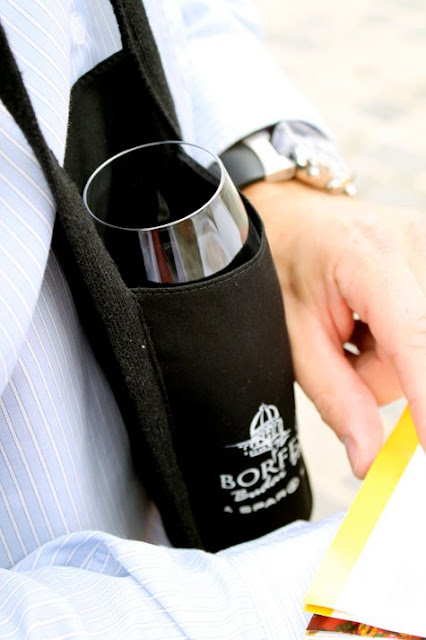 |
| Beautiful Alsace, France |
Let's not get too serious. Even though there's rules and etiquette you should know about your wines, you don't have to be a wine expert to visit a vineyard! It helps to have basic understanding of wine tasting, grapes and regions but you'll be completely fine by just having genuine interest in what you drink. However, visiting a vineyard can raise lots of questions if doing so for the first time.
 |
| Port wine barrels in Porto |
How to find the good ones?
There's plenty of information available online but also in books and food & wine magazines. Many online guides have wine routes you can follow and pretty much every region even has a website for the regional vineyards with addresses. We've been using Hugh Johnson's Pocket Wine book which has been ok for our purposes but there are also other similar books around. Choose the book depending on your level of wine knowledge and don't buy a pig in a poke as the books tend be quite different and often targeting certain type of audience.
A few links to popular wine routes and other information:
Alsace, France
Mosel, Germany
Piemonte, Italy
Amalfi Coast, Italy
http://www.marisacuomo.com/en/1034/tastings.htm
Spain
 |
| Taylor's, Porto, Portugal |
If possible, attend tastings before your trip to find local gems. Wine tastings are often arranged by wine shops, wine tasting courses or bars and restaurants in your region. You might not like the wines of the most popular and hyped vineyards at all, so do a bit of research (if possible) and find the ones you'd genuinely enjoy the most.
If you really want to become good at this, attend a wine course to learn all the ins and outs of wines, wine regions and tasting. It's a fascinating world!
We always like to taste the local wines even in regions not widely known as wine producers. There are some great wine regions in the Balkans, for instance in Croatia, Romania and FYR Macedonia, to mention a few. This is a fantastic way to explore wines you would normally not be able to buy where you live, therefor we highly recommend always asking for some local wine recommendations when traveling.
In case you already have favorite wines from the area you're visiting, make sure to visit the vineyards! You'll surely love your wines even more when you know where they're coming from.
Let them know you're coming!
Preparation is the key! Even though most vineyards and wineries are open on business hours and Saturdays, it's good to give them a call or send an email about your visit to make sure they are open and accepting visitors. Some of them are even open outside of the normal hours if you plan your visit in advance. When first visiting Alsace I was a little nervous as we don't speak any French but every vineyard I called spoke English as they get a lot of visitors from all over the world. We've never come across a wine maker who wasn't thrilled to have people over so give them a call and plan your visit! Most vineyards accept visitors even without making an appointment but it's always nicer to let them know in advance, if possible. However, if you stop by unannounced only to find the doors closed and fences locked, make a plan B and drop by another nearby vineward/winery.
We have normally informed the vineyards about our visit with an approximate time but have also popped in to some larger ones while driving by.
 |
| One of our favorite wines, Marisa Cuomo Furore Bianco, is made in this beautiful scenary on Amalfi Coast, Italy |
Planning and scheduling
You can either just buy the wines you already know you like (without tasting, even though tasting is always highly recommended) or taste and buy the ones you enjoyed the most - or not buy at all, really depending on how you feel about the wines. Every vineyard offers tastings so you know what you're buying. If planning several visits in one day it's a good idea to spit majority of the wines. You can really consume quite a lot of wines during one visit, getting tipsy really doesn't help your taste buds.
 |
Wine events and festivals are great source to find great wines. Budapest Borfeztival is a popular Hungarian wine event held annually.
|
One visit takes roughly one to two hours depending on what you're doing there. Tasting and buying is about an hour but if you're visiting a more touristic place it might take more than two in case you're taking a tour. I guess a fair estimate of three vineyards a day is a good pace when considering driving and tasting. Be prepared to wait for your turn in tastings and buying if it's busy.
 |
| Riquewihr, Alsace, France |
Storage and transportation
Storage and transportation is important when traveling with wines. If you are traveling by car, make sure the temperature stays around the same level the whole time without any temperature peaks, don't park the car in the sun or let it freeze as this will affect your wines in all the wrong ways and ruin it! When flying, make sure you pack your wines properly to prevent a small catastrophe. We've successfully flown with about 5 wine bottles in each large suitcase. Most wine producers offer shipping at reasonable prices which might be a good option to consider when buying more than a few bottles.
 |
| Trier in Germany is famous for it's wines. And they are good! |


























